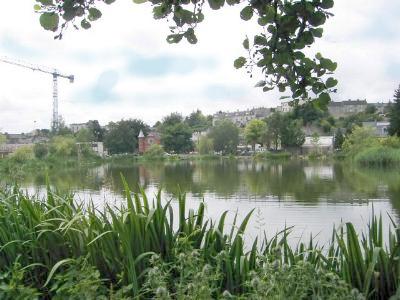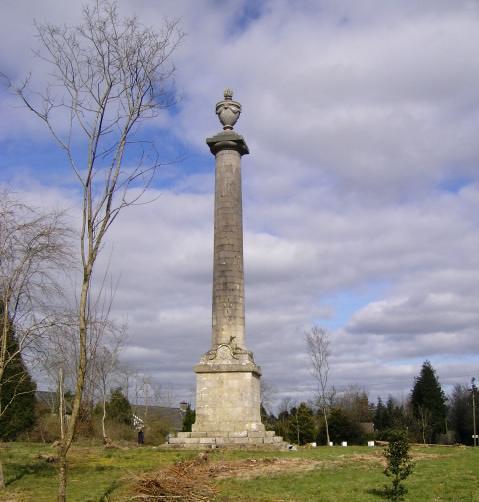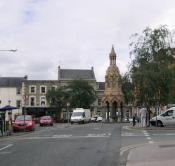
|
County
Monaghan has an area of 1,291 sq. Km, its name comes from the Irish
Muineachan (a place of bushes or little hills). It is one of the
three counties in the province of Ulster
that are not part of Northern Ireland. For more than half of its
length, Monaghan's boundary is the border with Northern Ireland.
Fermanagh is to the west, Tyrone to the north, and Armagh to the
east. In the Republic of Ireland, Louth is to the southeast, Meath
to the south, and Cavan to the southwest.
Most of the land is farmed with
about three per cent cultivated, the remainder is used for beef
and milk production. Poultry rearing is an important part of the
economy. About 25% of the population work in agriculture. Scattered
villages and small towns lie in a pastoral landscape. The largest
towns are Monaghan, Castleblayney,
Clones, Ballybay and Carrickmacross the latter is renowned for its
production of fine lace.
One of Irelands foremost poets Patrick
Kavanagh was born at Mucker near Inniskeen County Monaghan.
|
Monaghan is primarily a pastoral county where the pace of life is perhaps a little
more relaxed than other more industrialized counties, it is an ideal destination
for a relaxing weekend break or holiday, the county has many fine hotel
and guest houses
catering for all budgets. If equestrian
activities are your forte, Monaghan has several excellent Center's. The
fisherman is also well
catered for.
is primarily a pastoral county where the pace of life is perhaps a little
more relaxed than other more industrialized counties, it is an ideal destination
for a relaxing weekend break or holiday, the county has many fine hotel
and guest houses
catering for all budgets. If equestrian
activities are your forte, Monaghan has several excellent Center's. The
fisherman is also well
catered for.
The lowest land is on a band of limestone from
Clones to Monaghan. To the northwest, the land surface rises to 300 metres
(984 Ft) in the Slieve Beagh plateau. To the southeast, the rise is gentler,
and much of the county is lowland. The small rounded hills, combined with
lakes or bogs, are distinctive features of Monaghan's landscape.
About 25 per cent of of the population are  employed
in manufacturing, food processing is the largest sector of industry, and
includes the processing of meat, milk, and mushrooms. Some engineering
industries are also related to farming, and supply agricultural equipment.
The manufacture of furniture and wood products is also carried on. Monaghan
town is the largest centre of manufacturing, followed by Carrickmacross,
which is famous for its lace. Monaghan together with its neighboring county
Cavan form one constituency, and send five members of parliament to Dail
Eireann. Monaghan lost more than 25% of its population during the Great
Famine of the 1840's.
employed
in manufacturing, food processing is the largest sector of industry, and
includes the processing of meat, milk, and mushrooms. Some engineering
industries are also related to farming, and supply agricultural equipment.
The manufacture of furniture and wood products is also carried on. Monaghan
town is the largest centre of manufacturing, followed by Carrickmacross,
which is famous for its lace. Monaghan together with its neighboring county
Cavan form one constituency, and send five members of parliament to Dail
Eireann. Monaghan lost more than 25% of its population during the Great
Famine of the 1840's.
The Dawson Monument stands by the
roadside between the towns of xxxxxxxxxx and xxxxxxx, it bears the inscription
below
This column was erected
By the FREE and INDEPENDENT ELECTOR'S
of the COUNTY of MONAGHAN
to PERPETUATE the MEMORY
of RICHARD DAWSON Esq
Who was Unanimously Returned by them
To FIVE successive PARLIAMENTS
HE DIED their Faithful REPRESENTATIVE
on the 3rd September 1807
Aged 44 Years.
Tourist Information
M:TEK Building,
Knockaconny,
Monaghan
Co Monaghan
Tel +353 (0)47 81122
E Mail
Web Site
|
Summer only.
Read about County
Monaghan up to 1837
|


 is primarily a pastoral county where the pace of life is perhaps a little
more relaxed than other more industrialized counties, it is an ideal destination
for a relaxing weekend break or holiday, the county has many fine
is primarily a pastoral county where the pace of life is perhaps a little
more relaxed than other more industrialized counties, it is an ideal destination
for a relaxing weekend break or holiday, the county has many fine  employed
in manufacturing, food processing is the largest sector of industry, and
includes the processing of meat, milk, and mushrooms. Some engineering
industries are also related to farming, and supply agricultural equipment.
The manufacture of furniture and wood products is also carried on. Monaghan
town is the largest centre of manufacturing, followed by Carrickmacross,
which is famous for its lace. Monaghan together with its neighboring county
Cavan form one constituency, and send five members of parliament to Dail
Eireann. Monaghan lost more than 25% of its population during the
employed
in manufacturing, food processing is the largest sector of industry, and
includes the processing of meat, milk, and mushrooms. Some engineering
industries are also related to farming, and supply agricultural equipment.
The manufacture of furniture and wood products is also carried on. Monaghan
town is the largest centre of manufacturing, followed by Carrickmacross,
which is famous for its lace. Monaghan together with its neighboring county
Cavan form one constituency, and send five members of parliament to Dail
Eireann. Monaghan lost more than 25% of its population during the 